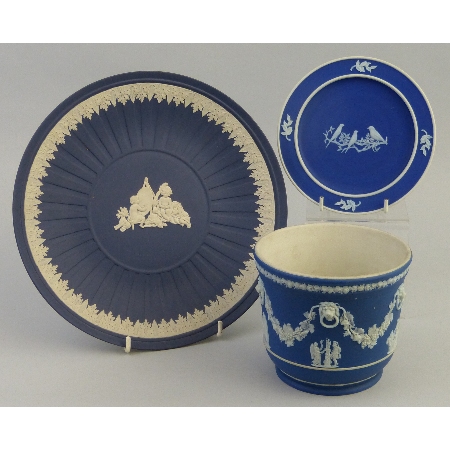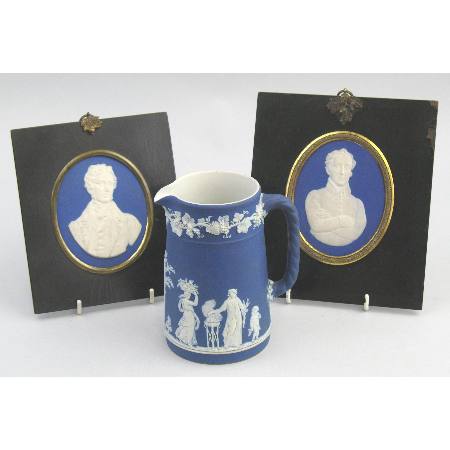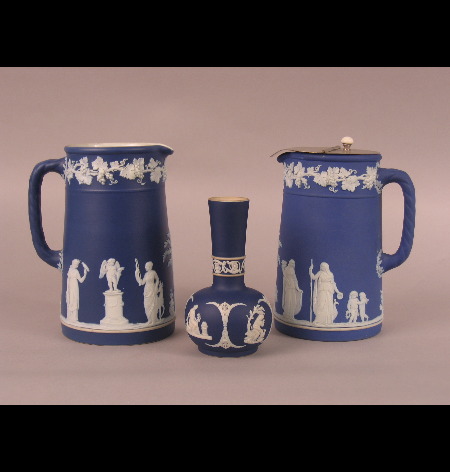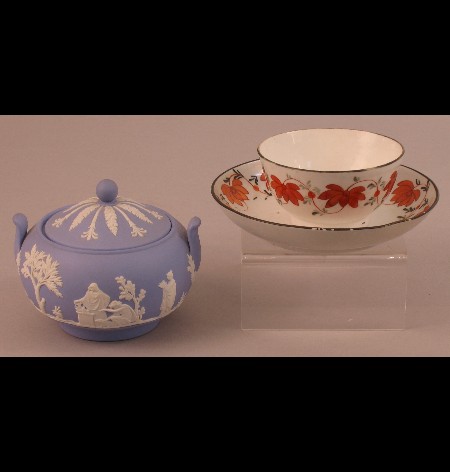‡ A WEDGWOOD BLUE JASPER MODEL OF THE PORTLAND VASE
CIRCA 1791
The twin-handled blue urn sprigged in white relief with the typical frieze of draped classical figures and the base with Paris in the Phrygian cap
25cm high
Note: The Portland Vase, now in the British Museum, is believed to have been made around 27 BC. The superb example of cameo glass-cutting inspired Josiah Wedgwood to try to match the skill of the ancient craftsmen but using black jasperware, the unique clay material developed by Josiah Wedgwood himself. According to Robin Reilly, Wedgwood: The New Illustrated Dictionary, p. 340, when supplies of the black clay ran out in 1791 some fine blue Portland vases, were produced. There is no record of any solid blue vases produced during the previous ten years and this vase was probably one of those made during the shortage of black clay. See the sold blue jasperware example of circa 1791 in the British Museum (1802,0312.1).
This vase shows the distinctive features of the early Wedgwood Portland vases, but is unnumbered. The portrait of Paris faithfully copies the glass original, with the tip of his elbow being cut off by the edge of the base. The tiny pin pricks visible around the edge of the base suggest that the vases were fired in the upright position, perhaps on a support dusted with sand to prevent sticking.
Condition Report:
Several small and sizeable foot rim chips. Firing cracks to the sprigging generally.
Please ask for the additional images available from the Dept. upon request.
Condition Report Disclaimer
‡ A WEDGWOOD BLUE JASPER MODEL OF THE PORTLAND VASE
CIRCA 1791
The twin-handled blue urn sprigged in white relief with the typical frieze of draped classical figures and the base with Paris in the Phrygian cap
25cm high
Note: The Portland Vase, now in the British Museum, is believed to have been made around 27 BC. The superb example of cameo glass-cutting inspired Josiah Wedgwood to try to match the skill of the ancient craftsmen but using black jasperware, the unique clay material developed by Josiah Wedgwood himself. According to Robin Reilly, Wedgwood: The New Illustrated Dictionary, p. 340, when supplies of the black clay ran out in 1791 some fine blue Portland vases, were produced. There is no record of any solid blue vases produced during the previous ten years and this vase was probably one of those made during the shortage of black clay. See the sold blue jasperware example of circa 1791 in the British Museum (1802,0312.1).
This vase shows the distinctive features of the early Wedgwood Portland vases, but is unnumbered. The portrait of Paris faithfully copies the glass original, with the tip of his elbow being cut off by the edge of the base. The tiny pin pricks visible around the edge of the base suggest that the vases were fired in the upright position, perhaps on a support dusted with sand to prevent sticking.
Condition Report:
Several small and sizeable foot rim chips. Firing cracks to the sprigging generally.
Please ask for the additional images available from the Dept. upon request.
Condition Report Disclaimer







/699/1228699.jpg)





/759/1228759.jpg)

Testen Sie LotSearch und seine Premium-Features 7 Tage - ohne Kosten!
Lassen Sie sich automatisch über neue Objekte in kommenden Auktionen benachrichtigen.
Suchauftrag anlegen